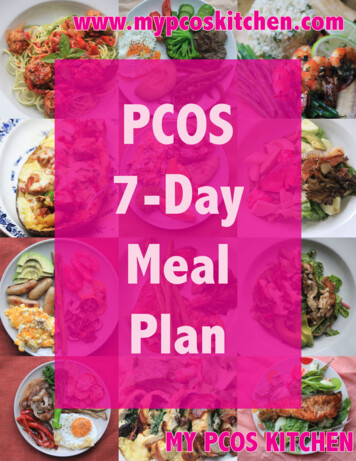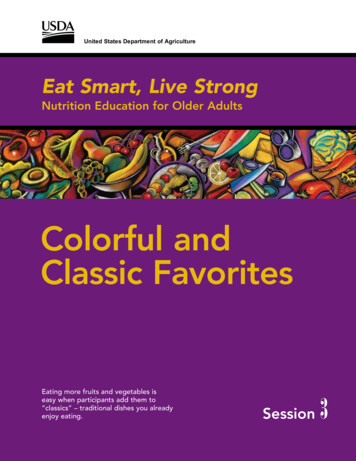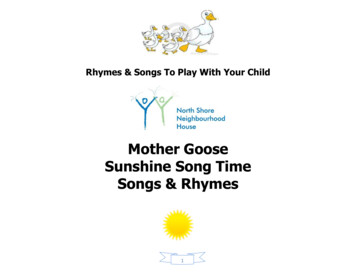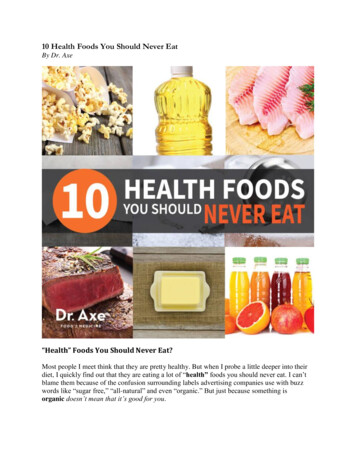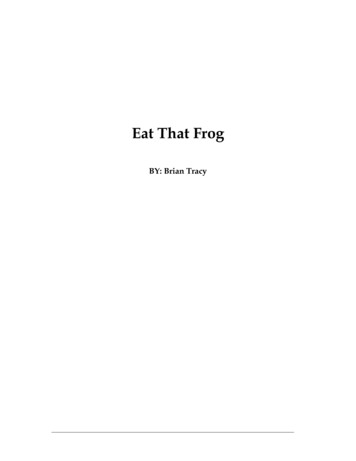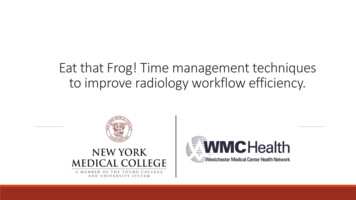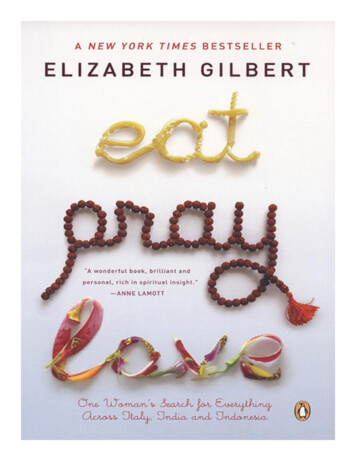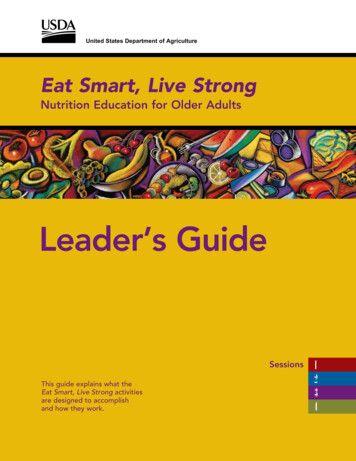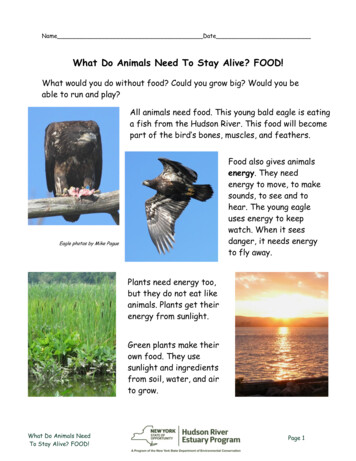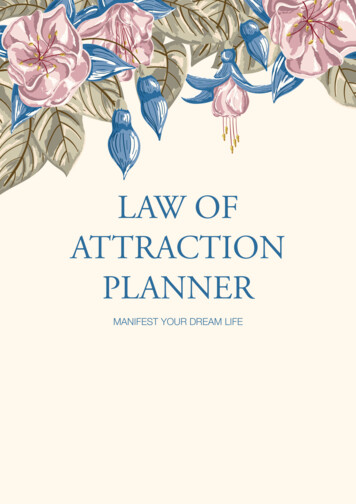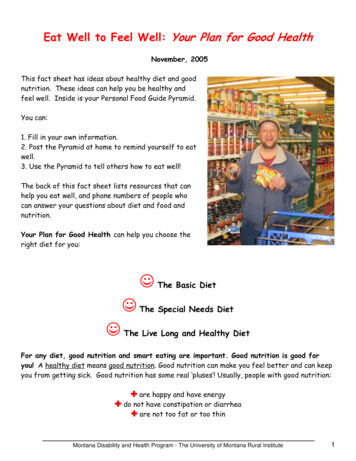
Transcription
Eat Well to Feel Well: Your Plan for Good HealthNovember, 2005This fact sheet has ideas about healthy diet and goodnutrition. These ideas can help you be healthy andfeel well. Inside is your Personal Food Guide Pyramid.You can:1. Fill in your own information.2. Post the Pyramid at home to remind yourself to eatwell.3. Use the Pyramid to tell others how to eat well!The back of this fact sheet lists resources that canhelp you eat well, and phone numbers of people whocan answer your questions about diet and food andnutrition.Your Plan for Good Health can help you choose theright diet for you:(((The Basic DietThe Special Needs DietThe Live Long and Healthy DietFor any diet, good nutrition and smart eating are important. Good nutrition is good foryou! A healthy diet means good nutrition. Good nutrition can make you feel better and can keepyou from getting sick. Good nutrition has some real ‘pluses’! Usually, people with good nutrition:[ are happy and have energy[ do not have constipation or diarrhea[ are not too fat or too thinMontana Disability and Health Program - The University of Montana Rural Institute1
Smart eating is up to you! S-M-A-R-T eating means five simple things: (1) Storeyour food safely; (2) Shop wisely to save Money; (3) Ask to learn more abouteating well; (4) Take Responsibility for choosing healthy foods; and (5) Make mealsthat Taste great.The Basic DietThe basic diet gives you what you need every day. It keeps you well. It gives you enough energyto do the things you want to do. What does the basic diet have?U Allthe nutrients that most healthy people need. (Nutrients are things like vitamins, protein,calcium and iron).UFoods that you like and that are good for you. You do not have to eat foods you hate.Some things that taste good are not part of a basic diet. Things like cookies and soda pop donot have nutrients your body needs.UFoods that fit the way you think and live. If your religion says you must not eat somefoods, do not eat them. Some religions say you should not eat meat that comes from pigs.Meat from pigs includes ham, bacon and pork chops. Some people do not eat meat at all.ULots of fruits and vegetables and whole grains. Fruits, vegetables and whole grains havemany of the nutrients you need. Whole wheat bread, brown rice, corn bread, oatmeal andbran flakes cereal have whole grains. They are healthier than white bread, white rice, andsugary cereal.UClean and safe food. Germs can grow in food and spoil it and make you sick. Cold foods likecheese and tuna salad must stay cold until you eat them or put them in the refrigerator. Hotfoods, like chili and roast chicken, must stay hot until you eat them or put them in therefrigerator.U Exerciseand move your body! Exercise and moving your body are part of the basic diet.The foods you eat give your body the energy to move. If you do not use the energy, youmight get fat or sick. If you eat good food, exercise and move, your body will work right.How Do I Get a Basic Diet? Use your Personal Food Guide and your Food Guide Pyramid tomake a plan to get everything your body needs for the next week. Write down all the meals andsnacks you will eat. Then you won’t have to think about what to eat every day. You can write yourchoices on your Food Guide Pyramid. It can help you make your own menus. It shows what kindsof foods you need to eat and drink, and how much of each thing you need to be healthy. A planalso helps you save money on groceries.2Montana Disability and Health Program - The University of Montana Rural Institute
The Special Needs DietThe Special Needs Diet is a healthy diet that has what your own body needs. It leaves outfoods that are not good for you. If you need a special diet, please learn as much about it as youcan. Your food might be cooked in a special way. If you have diabetes, learn what foods aresafe to eat. If you need a low fat diet, find out which foods have a lot of fat and which foodshave a little fat. If the Food Guide Pyramid does not have what your body needs, talk to yourdoctor, a nutritionist or a dietitian. They can help you make menus for a Special Needs Diet. ASpecial Needs Diet is good for:People who have trouble chewing and swallowing food: A doctor might say that some foodsshould be put in a blender. Some food might be cut up into small pieces that are easy to chewand swallow. People who have trouble chewing and swallowing should not eat food that mightmake them choke.People who have the flu: People with the flu might need to drink more liquid than usual. Adoctor can say what liquids are good for the flu and how much to drink.People with diarrhea or constipation: A doctor or a dietitian knows what foods are good forhealthy bowel movements. Some people with diarrhea or constipation have a food allergy. Adoctor can figure out what foods cause problems. Then the doctor or a dietitian can replacethose foods with other healthy choices.People with diabetes: Doctors and dietitians work to make sure that people with diabetes havediets with the right amount and types of sugars and other foods. Proper diets give people withdiabetes the energy they need to be healthy and live active lives.People with cancer: People with cancer usually have a team of doctors helping them. Thedoctors work with dieticians to plan a special needs diet that makes cancer patients stronger sothey can fight their disease.Overweight or underweight people: Overweight people might need a low-fat or low-calorie diet.A dietitian can help plan this kind of special needs diet. A dietitian can also plan a special needsdiet for people who need to gain weight.People who don’t move much: Some people are not able to exercise or move much. These peoplemight not be using much energy and they don’t need as much food as other people. A doctor or adietitian can help plan a healthy diet so these people don’t get fat.Montana Disability and Health Program - The University of Montana Rural Institute
The Live Long and Healthy DietIf you eat a good Basic Diet or Special Needs Diet that meets your every day needs, whatcomes next? The Live Long and Healthy Diet does more than the basic diet and the specialneeds diet. Every day the Live Long and Healthy Diet gives your body what it needs to behealthy plus it can help you live a long time! If you eat a Live Long and Healthy Diet you mayfeel happier and have more energy. You might not get diarrhea, constipation, heart disease orcancer.Here are some ideas for a Live Long and Healthy Diet:1. Eat mostly fruits, vegetables, whole grains, beans, and low-fat milk products.2. Choose foods low in fat, sugar and salt. Junk food has a lot of fat, sugar and salt.3. Think before you eat candy, pizza, or soda. Will they help you live a long and healthy life? Alittle junk food is ok for parties, but eat only one serving.4. Most people need a daily vitamin and mineral supplement. Ask your doctor if you need avitamin and mineral supplement. If you need one, take the kind your doctor suggests. Do nottake extra vitamins or supplements. Too much of a supplement can make you sick.5. Talk to your doctor at each visit about other ideas for a Live Long and Healthy Diet.Your Nutrition Rights!!!!!!!You have the right to a basic diet that meets your body’s needs and keeps you healthy.!You have the right to be respected and treated fairly by food and nutrition professionals.You have the right to a diet that follows your beliefs.You have the right to safe food that is served in a pleasant way.You have the right to a diet with many kinds of fresh, whole foods.You have the right to choose foods you will or will not eat.You have the right to know about your special needs and foods that work for you.You have the right to be part of food and nutrition research studies and of groups thatdecide how you should eat and stay healthy.Montana Disability and Health Program - The University of Montana Rural Institute4
List of WordsA Diet is all the foods that you usually eat.A Basic Diet has enough of the right kinds of food to help your body work properly.A Special Diet has enough of the right foods for a person whose body works differentlythan most other people’s bodies. People who are too fat or too thin need a special diet.People with diabetes or seizures or food allergies also might need special diets.A Live Long and Healthy Diet helps your body work better and live longer.Exercise is physical activity that gets your body moving.Junk Food doesn’t have many nutrients. It usually has a lot of fat or sugar or salt. Candy, cake,cookies, chips and ice cream are junk food. Many junk foods are eaten out of a package orheated in a microwave or oven. Other junk foods are fast food restaurant fries, soda pop, TVdinners, frozen pizza, hot dogs, baloney, canned soup, ramen noodles, and microwave popcorn.Low-fat foods have less fat that gets stored in your body. Many foods have some fat in them.Junk foods might have a lot of fat.A Menu is a plan for all the food you will eat for one meal or in one day or one week. You canmake a menu for a whole week of meals at one time. You can list foods for breakfast, lunch,dinner and snacks. A menu helps you plan a good diet, and saves money and time on shopping.Nutrients are the parts of your food that keep your body healthy and working well. Vitaminsand minerals are nutrients. Calcium is a nutrient in milk that is good for your bones. Protein is anutrient in meat, chicken, fish, beans, nuts, tofu, and milk that helps your body work right, growstrong, and heal when it gets hurt.A Nutritionist or dietitian is an expert on diets and foods who helps people plan a good diet.A Serving is the amount of a food that you should eat. One slice of bread is one serving, so asandwich counts as two bread servings. You might need to use measuring spoons and cups to seehow much one serving is for some foods. One measuring cup of milk is a serving. One measuringtablespoon of salad dressing is a serving. If the Personal Food Guide says:Cup - Use a measuring cup, not a coffee mug or a tea cup. A measuring cup might hold more orless food or liquid than a drinking cup.Oz. - Means “ounce”. Some foods, like yogurt or soda pop, show the number of ounces on thepackage. For meat, chicken, fish, or cheese, use Food Guide serving sizes.Tbl. - tablespoon. Use a measuring spoon, not an eating spoon.Tsp. - teaspoon. Use a measuring spoon, not an eating spoon.Resources: Write the names and telephone numbers of people and offices in your town that can answer5Montana Disability and Health Program - The University of Montana Rural Institute
your questions and help you learn about food and nutrition. If you call and no one answers, leave amessage asking the person to call you back.NameTelephone numberNutritionist or dietitianPublic Health DepartmentCounty Extension Foods/Nutrition AgentHealth care providerUse your phone or computer to learn more about nutrition! Here’s where to start:Cooperative Extension Service agents know aboutmenu planning, food budgets, and other topics. Tofind your County Extension office, call 202-7207441 and ask for the phone number of your countyoffice or mlClick on your state. Find your county office.Dietary Guidelines for Americans can help you,your family, or your assistants make healthy foodthat taste good too. Go tana Disability and Health Program hasnutrition resources for persons with rectory/Nutrition.htm or call 406-243-2460.National Center for Physical Activity andDisability has information about exercise andactivity for persons with all types of disabilities.http://www.ncpad.org/Government Center for Food Safety Go tohttp://www.foodsafety.govWe based Eat Well to Feel Well: Your Plan for Good Health on what we know about nutrition foradults with physical disabilities and adults without disabilities. As we learn more about nutritionfor adults with intellectual disabilities, we will update the Plan. Please tell us what you thinkabout Your Plan for Good Health!Contact: Kathleen Humphries, Ph.D., khumphries@ruralinstitute.umt.eduMontana Disability and Health Program: Living Well Under the Big Sky, Research and TrainingCenter on Disability in Rural Communities, The University of Montana Rural Institute, 52 Corbin Hall,Missoula, MT 59812-7056 888-268-2743 toll-free; 406-243-5467 Voice; 406-243-4200 TTY406-243-2349 (fax) institute.umt.eduThis guide was supported by grant #U59/CCU82122401 from the Centers for Disease Control & Prevention(CDC). The contents are solely the responsibility of theauthors and do not necessarily represent the officialviews of CDC. RTC: Rural, 2005.Prepared by Kathleen Humphries, Meg Traci, & TomSeekins. Reviewed by People First members, MTDHAdvisory Board, & Montana Dietetics AssociationExecutive Board. Available in Braille, large print, andtext file formats.Montana Disability and Health Program - The University of Montana Rural Institute
Food Guide Pyramid forLong DescriptionI eat servings each dayFavoritesI eat servings each dayFavoritesI eat -servings each dayI eat servingseach dayFavoritesFavoritesI eat servingseach dayI eat servin gseach dayFavoritesDrinksI drink glasses each dayFavorites 11.\My favorite moving activities e
Standards of Care Personal Food Guide rasOne Serving is:Suggested ServingsMyNeeds1 slice bread½ bagel or bun3 - 4 crackersSmall pancake or waffle½ cup cooked rice or cooked noodles1 cup cold cereal or ½ cup hot cereal¾ Less Food: 5¾ Medium Amount: 6¾ More Food: 7½ cup raw vegetables½ cup cooked vegetables1 cup leafy vegetables (lettuce)1 small baked potato (French fries do notcount)¾ c. vegetable juice¾ Less Food: 2½¾ Medium Amount: 3½¾ More Food: 51 medium piece of fresh fruit½ cup berries or fruit slices½ cup canned, frozen, or cooked fruit¼ cup dried fruit (raisins, dried apricots)¾ cup fruit juice – limit to 1 serving a day¾ Less Food: 2½¾ Medium Amount: 3¾ More Food: 41 cup of milk1 cup of yogurt (8 oz. container)1 cup of soy milk or soy yogurt1 ½ ounces of cheese (this is one slice)¼ cup grated cheese¾ Less Food: 2-3¾ Medium Amount: 3¾ More Food: 32-3 oz. of cooked meat, chicken, or fish(about the size of the palm of the hand)2 eggs3-4 Tbl. peanut butter1 cup cooked beans½ cup tofu or nuts¾ Less Food: 2¾ Medium Amount: 2¾ More Food: 2½1 Tbl. dressing, cream or coffee creamer1 tsp. mayonnaise, butter or margarine1 small handful of potato chips or other chips1 piece of cake (the size of a cupcake)12 oz. soda pop½ c ice cream and sherbet¾ Less Food: 1¾ Medium Amount: 1 ½¾ More Food: 2Long DescriptionPersonal Favorites
it can help you live a long time! If you eat a Live Long and Healthy Dietyou may feel happier and have more energy. You might not get diarrhea, constipation, heart disease or cancer. Here are some ideas for a Live Long and Healthy Diet: 1. Eat mostly fruits, veget
